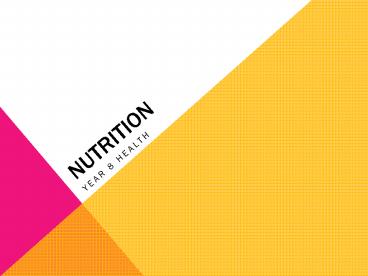Nutrition - PowerPoint PPT Presentation
Title:
Nutrition
Description:
Title: Sports Nutrition Author: bayliss Last modified by: Ashlea Created Date: 11/14/2001 4:29:50 PM Document presentation format: On-screen Show (4:3) – PowerPoint PPT presentation
Number of Views:185
Avg rating:3.0/5.0
Title: Nutrition
1
Nutrition
- Year 8 health
2
Nutrition and good health
- WHAT IS NUTRITION?
- The process of absorbing nutrients from food for
the use of growth, repair and maintenance of the
body. - GOOD HEALTH
- Ensure a balanced diet is maintained and regular
participation in physical activity (everyday) - Energy intake (food) should equal energy
expenditure (physical activity)
3
Health risks of overweight individuals
4
Body shape
- One of the reasons weight loss and body image are
complicated is because people have certain
natural body shapes that differ - There are three main types
- Endomorph
- Mesomorph
- Ectomorph
5
Endomorph
- Rounded bodies
- Obvious stomach hips and thighs,
- Gain weight easily
6
Mesomorph
- Lean and muscular
- Broad shoulders
- Narrow waist
- Easily develop muscle
7
Ectomorph
- Tall, thin and long limbed
- Difficult to put on weight
8
Nutrition at puberty
- Most teens dont need to gain or lose weight.
- Dieting can interfere with normal growth and
development, especially during puberty. - Extra weight during teenage years can turn into
height later. - Too little weight now will usually catch up after
height in reached. - Muscle develops significantly after puberty.
9
What is food for?
- Energy
- Growth and repair
- Regulation of body processes
10
What should we eat?
- The body needs the following nutrients
- Energy Use
- Protein
- Fat
- Carbohydrates
- Vitamins
- Minerals
- Water
11
Protein
- Make up the major part of all body cells, tissues
and systems - Needed for growth, repair and energy
- Sources are fish, meat, eggs, milk, nuts
12
Fats
- Provide cushion around vital organs and
insulation - Source of energy
- Absorb vitamins (A,D,E K)
- Sources are nuts, oils, dairy, meat
13
Carbohydrates
- Digested into glucose
- major body fuel provides 70 of energy
- used to make ATP essential to muscle
contraction - Excess converted to glycogen or fat
- Sources are vegetables, fruit, bread, rice, pasta
14
Vitamins
- A, B, C, D, E, K
- Needed in small amounts for growth and good
health, help the body in various metabolisms - Not used for energy
- Most provided by food milk, fish and vegetables
15
Minerals
- Used with other nutrients to ensure smooth
functioning body - Major ones include iron (clotting) calcium (bone
growth) and phosphorous (energy production) - Sources are fish, vegetables, fruit
16
(No Transcript)
17
How many serving?
- Eat Most
- Fruits and vegetables
- Breads and cereals such as rice and pasta
- Beans and lentils
- Serving per day 4-6 servings per day
18
How many servings?
- Eat Moderately
- Dairy products such as milk, cheeses and yoghurts
- Lean meat
- Chicken
- Fish
- Nuts
- Serving per day 2- 3 servings per day
19
How many servings?
- Eat Least
- Chocolate, potato chips, ice-cream, lollies etc
- Serving per day 0-1 servings per day
20
How much should we eat?
- Your energy needs per day are based on the base
level of your metabolism plus how much exercise
you do. - Metabolism is how quickly you burn energy
- Energy is burnt at different rates depending on
intensity of exercise. - KEY POINT
- Energy intake should not be greater than energy
expenditure
21
Energy use and activity
22
How much energy is there in food?
Food Kilojoules Measurement
Bread 1250 5 slices 130g
Cornflakes 1600 4 bowls 130g
Apple 300 130g
Potato - baked 720 130g
Cauliflower 130 130g
Beef steak 1830 130g
Chicken 950 130g
Lamb chop 1800 130g
Fish steamed / grilled 630 130g
Fish fried 1300 130g
Cheese - cheddar 1800 130g
Milk - skimmed 200 130g half a glass
Milk full fat 350 130g half a glass
Drink (carbonated) 250 130g - third of a can
23
Junk Food
- 3 main problems
- 1. Unneeded calories contain more calories than
needed, can of drink 756Kj, water has none. High
in fat and sugar. - 2. Empty Calories none of the minerals vitamins
or fibre you need. - 3. High in salt too much salt in the diet leads
to high blood pressure and heart disease.































